2023 SUBARU BRZ stop start
[x] Cancel search: stop startPage 248 of 432
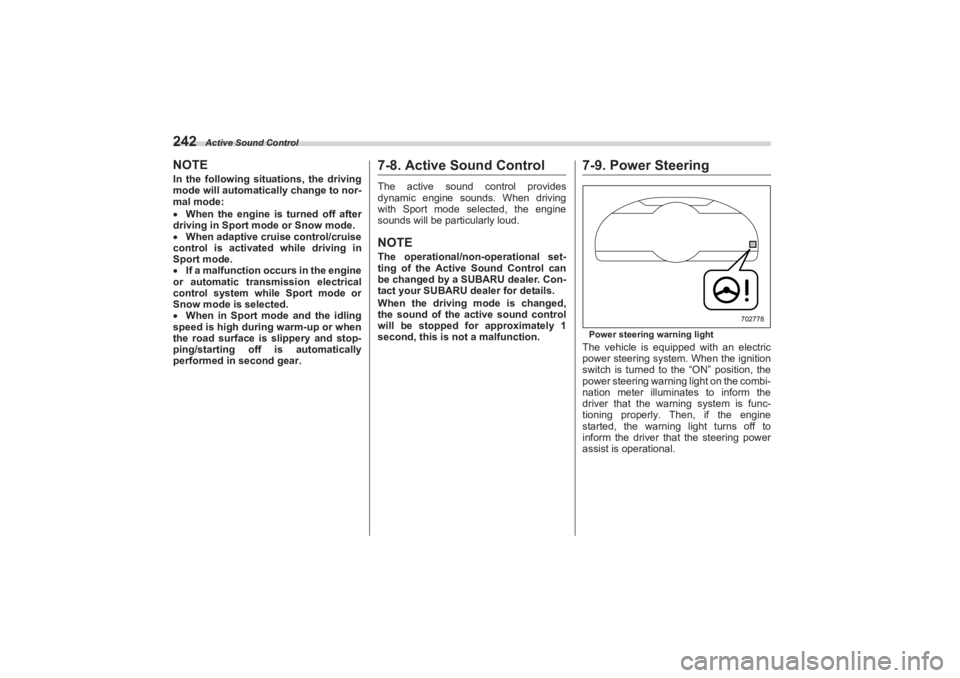
Active Sound Control
242NOTEIn the following situations, the driving
mode will automatically change to nor-
mal mode:
When the engine is turned off after
driving in Sport mode or Snow mode.
When adaptive cruise control/cruise
control is activated while driving in
Sport mode.
If a malfunction occurs in the engine
or automatic transmission electrical
control system while Sport mode or
Snow mode is selected.
When in Sport mode and the idling
speed is high during warm-up or when
the road surface is slippery and stop-
ping/starting off is automatically
performed in second gear.
7-8. Active Sound ControlThe active sound control provides
dynamic engine sounds. When driving
with Sport mode selected, the engine
sounds will be particularly loud.NOTEThe operational/non-operational set-
ting of the Active Sound Control can
be changed by a SUBARU dealer. Con-
tact your SUBARU dealer for details.
When the driving mode is changed,
the sound of the active sound control
will be stopped for approximately 1
second, this is not a malfunction.
7-9. Power SteeringPower steering warning lightThe vehicle is equipped with an electric
power steering system. When the ignition
switch is turned to the “ON” position, the
power steering warning light on the combi-
nation meter illuminates to inform the
driver that the warn ing system is func-
tioning properly. Then, if the engine
started, the warni ng light turns off to
inform the driver that the steering power
assist is operational.
702778
BRZ_U.book 242 ページ 2022年3月29日 火曜日 午後3時59分
Page 249 of 432
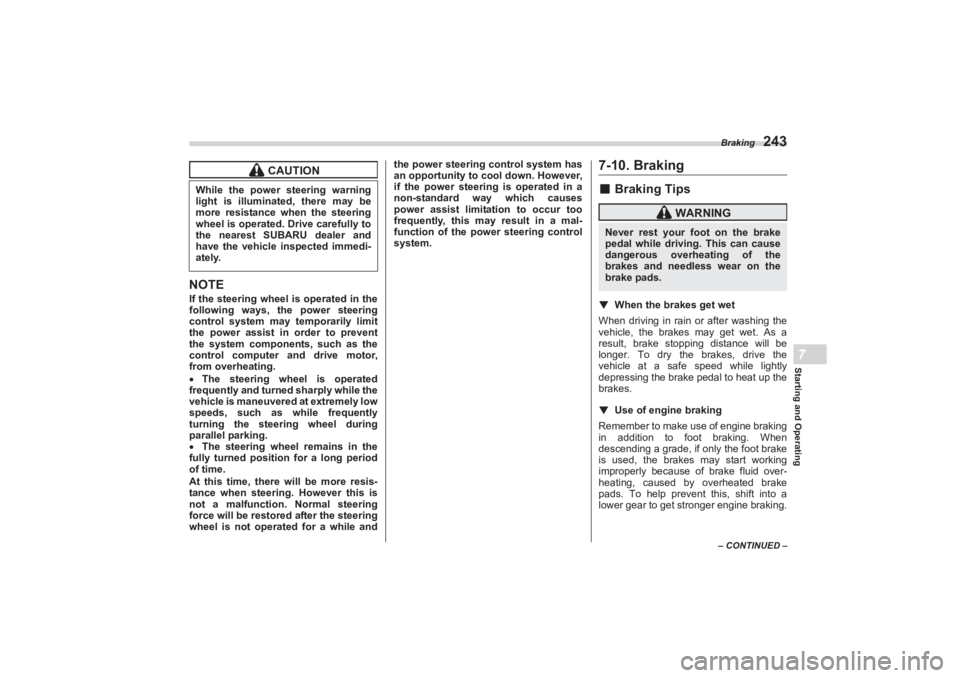
Braking
243
Starting and Operating7
– CONTINUED –
NOTEIf the steering wheel is operated in the
following ways, the power steering
control system may temporarily limit
the power assist in order to prevent
the system components, such as the
control computer and drive motor,
from overheating.
The steering wheel is operated
frequently and turned sharply while the
vehicle is maneuvered at extremely low
speeds, such as while frequently
turning the steering wheel during
parallel parking.
The steering wheel remains in the
fully turned position for a long period
of time.
At this time, there will be more resis-
tance when steering. However this is
not a malfunction. Normal steering
force will be restored after the steering
wheel is not operated for a while and the power steering control system has
an opportunity to cool down. However,
if the power steering is operated in a
non-standard way which causes
power assist limitation to occur too
frequently, this may result in a mal-
function of the power steering control
system.
7-10. Braking■ Braking Tips▼ When the brakes get wet
When driving in rain or after washing the
vehicle, the brakes may get wet. As a
result, brake stopping distance will be
longer. To dry the brakes, drive the
vehicle at a safe speed while lightly
depressing the brake pedal to heat up the
brakes.
▼ Use of engine brakingRemember to make use of engine braking
in addition to foot braking. When
descending a grade, if only the foot brake
is used, the brakes may start working
improperly because of brake fluid over-
heating, caused by overheated brake
pads. To help prevent this, shift into a
lower gear to get stronger engine braking.
CAUTION
While the power steering warning
light is illuminated, there may be
more resistance when the steering
wheel is operated. Drive carefully to
the nearest SUBARU dealer and
have the vehicle inspected immedi-
ately.
WARNING
Never rest your foot on the brake
pedal while driving. This can cause
dangerous overheating of the
brakes and needless wear on the
brake pads.
BRZ_U.book 243 ページ 2022年3月29日 火曜日 午後3時59分
Page 251 of 432
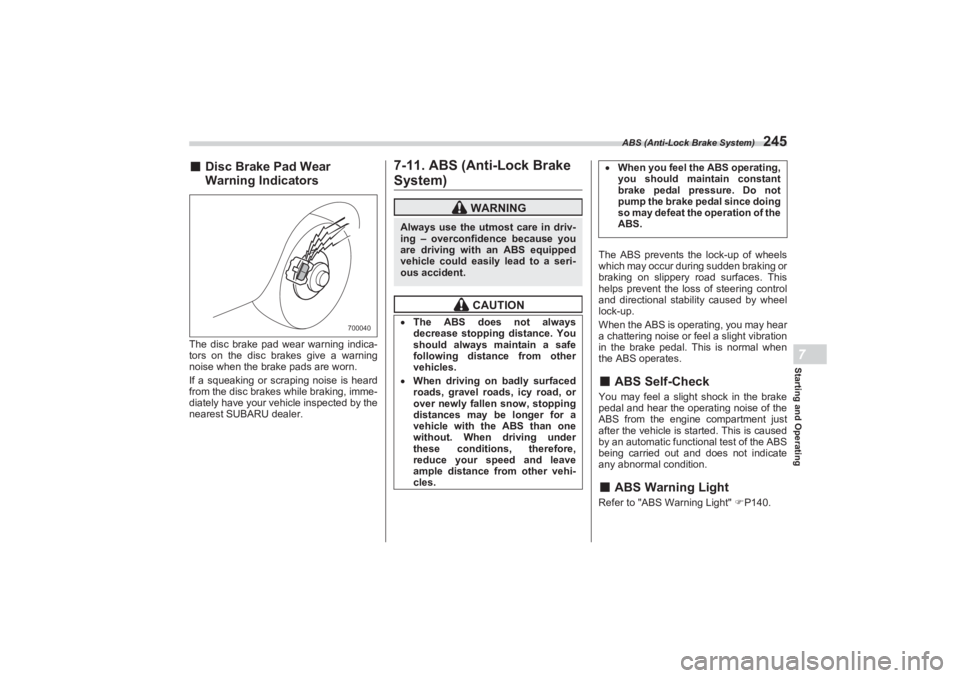
ABS (Anti-Lock Brake System)
245
Starting and Operating7
■Disc Brake Pad Wear
Wa rning IndicatorsThe disc brake pad wear warning indica-
tors on the disc brakes give a warning
noise when the brake pads are worn.
If a squeaking or scraping noise is heard
from the disc brakes while braking, imme-
diately have your vehicle inspected by the
nearest SUBARU dealer.
7-11. ABS (Anti-Lock BrakeSystem)
The ABS prevents the lock-up of wheels
which may occur during sudden braking or
braking on slippery road surfaces. This
helps prevent the loss of steering control
and directional stability caused by wheel
lock-up.
When the ABS is operating, you may hear
a chattering noise or f eel a slight vibration
in the brake pedal. This is normal when
the ABS operates.■ ABS Self-CheckYou may feel a slight shock in the brake
pedal and hear the operating noise of the
ABS from the engine compartment just
after the vehicle is started. This is caused
by an automatic functional test of the ABS
being carried out and does not indicate
any abnormal condition.■ ABS Warning LightRefer to "ABS Warning Light" P140.
700040
WARNING
Always use the utmost care in driv-
ing – overconfidence because you
are driving with an ABS equipped
vehicle could easily lead to a seri-
ous accident.
CAUTION
The ABS does not always
decrease stopping distance. You
should always maintain a safe
following distance from other
vehicles. When driving on badly surfaced
roads, gravel roads, icy road, or
over newly fallen snow, stopping
distances may be longer for a
vehicle with the ABS than one
without. When driving under
these conditions, therefore,
reduce your speed and leave
ample distance from other vehi-
cles.
When you feel the ABS operating,
you should maintain constant
brake pedal pressure. Do not
pump the brake pedal since doing
so may defeat the operation of the
ABS.
BRZ_U.book 245 ページ 2022年3月29日 火曜日 午後3時59分
Page 255 of 432

Vehicle Stability Control (VSC)/TRAC System
249
Starting and Operating7
– CONTINUED –
▼Disabling the TRAC System
If the vehicle gets stuck in mud, dirt or
snow, the TRAC system may reduce
power from the engine to the wheels.
Pressing the Vehicle Stability Control
(VSC) OFF switch to turn the system off
may make it easier for you to rock the
vehicle in order to free it. In this case, the
brake LSD function remains on. To turn
the TRAC system off, quickly press and
release the button. The TRAC OFF indi-
cator light will come on. Press the button
again to turn the system back on.
Creating adequate driving wheel slip by
deactivating the TRAC system may help
to recover from the loss of traction. Use
the Vehicle Stability Control (VSC) OFF
switch as necessary.
A standing start on a steeply sloping
road with a snowy, gravel-covered, or
otherwise slippery surface
Extrication of the vehicle when its
wheels are stuck in mud or deep snow ▼
Turning Off both Vehicle Stability
Control (VSC) and TRAC Systems
To turn the Vehicle Stability Control (VSC)
systems and TRAC system off, press and
hold the Vehicle Stability Control (VSC)
OFF switch for more than 3 seconds while
the vehicle is stopped. The TRAC OFF
indicator light and the Vehicle Stability
Control (VSC) OFF indicator light will
come on. However, on vehicles with an
automatic transmissi on, the brake LSD
function will remain on. Press the button
again to turn the systems back on. With
the Vehicle Stability Control (VSC) system
and TRAC system deactivated, traction
and stability enhancement offered by
Vehicle Stability Control (VSC) system
and TRAC system is unavailable. There-
fore you should not deactivate the Vehicle Stability Control (VSC) system and TRAC
system except under above-mentioned
situations.
NOTE When the switch has been pressed
to deactivate the Vehicle Stability
Control (VSC) system and TRAC
system, the Vehicle Stability Control
(VSC) system and TRAC system auto-
matically reactivates itself the next
time the ignition swit ch is turned to the
“OFF” position and the engine is
restarted.
If the switch is held down for 30
seconds or longer, the indicator light
turns off, the Vehicle Stability Control
(VSC) system is activated, and the
system ignores any further pressing of
the switch. To make the switch usable
again, turn the ignition switch to the
“OFF” position and restart the engine.
When the switch is pressed to deac-
tivate the Vehicle Stability Control
(VSC) system and TRAC system, the
vehicle’s running performance is
comparable with that of a vehicle that
does not have a Vehicle Stability
Control (VSC) system and TRAC
system. Do not deac tivate the Vehicle
Stability Control (VSC) system and
TRAC system except when absolutely
necessary.
702831
BRZ_U.book 249 ページ 2022年3月29日 火曜日 午後3時59分
Page 261 of 432

Parking Your Vehicle
255
Starting and Operating7
– CONTINUED –
■When Initialization of the Tire
Pressure Monitoring System
has FailedInitialization can be completed in a few
minutes. However, in the following case,
the settings have not been recorded and
the system will not o perate properly. If
repeated attempts to record tire inflation
pressure settings ar e unsuccessful, have
the vehicle checked at your SUBARU
dealer.
When operating the TPMS set switch,
low tire pressure warning light does not
blink 3 times.
After carrying out the initialization
procedure, the low tire pressure warning
light blinks for 1 minute then stays on after
driving for 20 minutes.
■ Registering ID CodesEvery tire pressure warning valve and
transmitter has a unique ID code. In addi-
tion to the set of tire pressure monitoring
system sensor ID code s initially registered
to the vehicle, a second set of ID codes
can be registered.
A second set of tire pressure monitoring
system sensor ID codes can be registered
at your SUBARU dealer. When 2 sets of
ID codes have been registered, either ID
code set can be selected.■ Changing the ID code set1. Park the vehicle in a safe place and
turn the ignition swit ch to the “ON” posi-
tion.
2. Press the TPMS set switch 3 times
within 3 seconds.
3. The low tire pressure warning light will
illuminate for 3 seconds and then blink 3
times.
4. The low tire pressure warning light will
blink for 1 minute and then illuminate.
5. When the ID code change has
completed, the tire pressure monitoring
light will turn off.
Check that tire pressures are displayed on
the TPMS screen.
7-16. Parking Your Vehicle■ Parking BrakeTo set the parking brake, depress the
brake pedal firmly and hold it down until
the parking brake lever is fully pulled up.
WARNING
Do not operate the TPMS set switch
without first adjust ing the tire infla-
tion pressure to the specified level.
Otherwise, the low tire pressure
warning light may not come on even
if the tire inflation pressure is low,
or it may come on when the tire
inflation pressure is actually nor-
mal.
WARNING
Never leave unattended children
or pets in the vehicle. They could
accidentally injure themselves or
others through inadvertent oper-
ation of the vehicle. Also, on hot
or sunny days, the temperature in
a closed vehicle could quickly
become high enough to cause
severe or possibly fatal injuries to
people. Do not park the vehicle over flam-
mable materials such as dry
grass, waste paper or rags, as
they may burn easily if they come
near hot engine or exhaust
system parts. Be sure to stop the engine if you
take a nap in the vehicle. If engine
exhaust gas enters the passenger
compartment, occupants in the
vehicle could die from carbon
monoxide (CO) contained in the
exhaust gas.
BRZ_U.book 255 ページ 2022年3月29日 火曜日 午後3時59分
Page 263 of 432
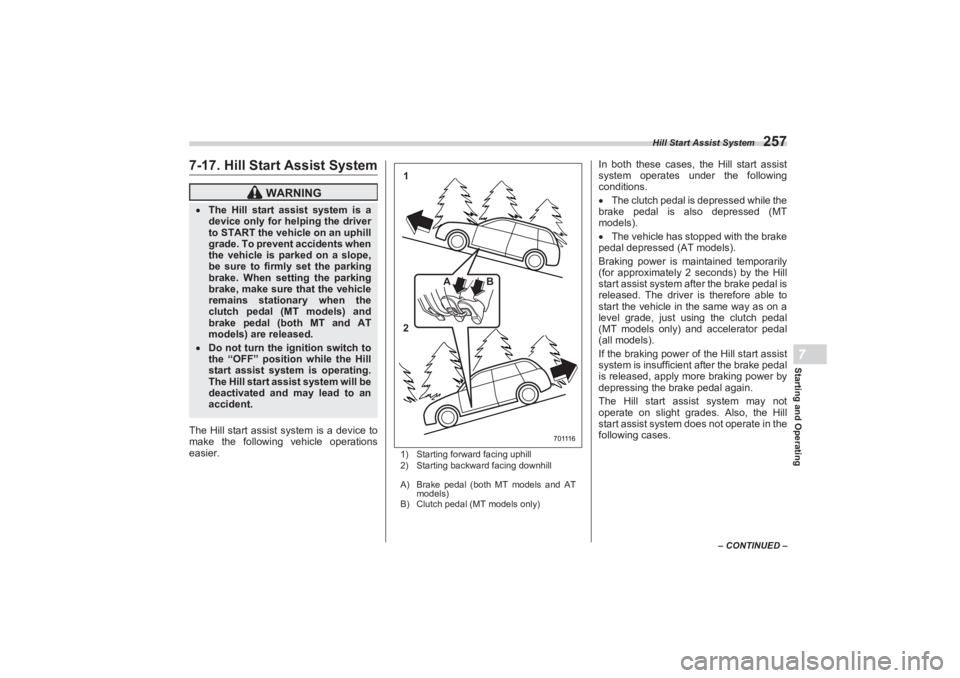
Hill Start Assist System
257
Starting and Operating7
– CONTINUED –
7-17. Hill Start Assist SystemThe Hill start assist system is a device to
make the following vehicle operations
easier.
1) Starting forward facing uphill
2) Starting backward facing downhill
A) Brake pedal (both MT models and AT
models)
B) Clutch pedal (MT models only)
In both these cases, the Hill start assist
system operates under the following
conditions.
The clutch pedal is depressed while the
brake pedal is also depressed (MT
models).
The vehicle has stopped with the brake
pedal depressed (AT models).
Braking power is maintained temporarily
(for approximately 2 seconds) by the Hill
start assist system after the brake pedal is
released. The driver is therefore able to
start the vehicle in the same way as on a
level grade, just using the clutch pedal
(MT models only) and accelerator pedal
(all models).
If the braking power of the Hill start assist
system is insufficient after the brake pedal
is released, apply more braking power by
depressing the brake pedal again.
The Hill start assist system may not
operate on slight grades. Also, the Hill
start assist system does not operate in the
following cases.
WARNING
The Hill start assist system is a
device only for helping the driver
to START the vehicle on an uphill
grade. To prevent accidents when
the vehicle is parked on a slope,
be sure to firmly set the parking
brake. When setting the parking
brake, make sure that the vehicle
remains stationary when the
clutch pedal (MT models) and
brake pedal (both MT and AT
models) are released. Do not turn the ig nition switch to
the “OFF” position while the Hill
start assist system is operating.
The Hill start assist system will be
deactivated and may lead to an
accident.
1
2 BA
7 0 111 6
BRZ_U.book 257 ページ 2022年3月29日 火曜日 午後3時59分
Page 269 of 432
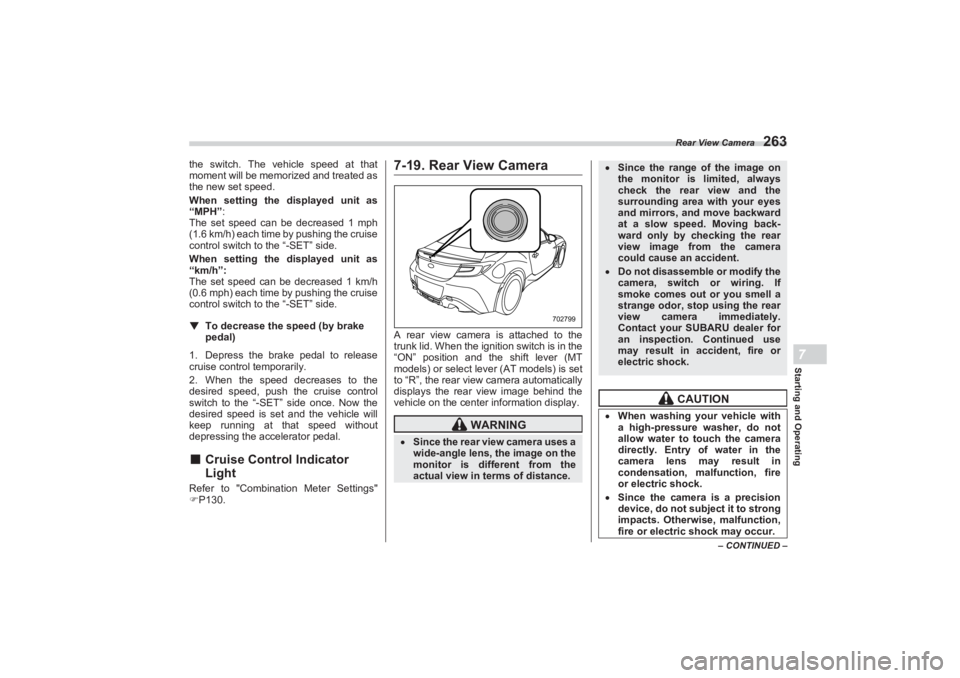
Rear View Camera
263
Starting and Operating7
– CONTINUED –
the switch. The vehicle speed at that
moment will be memorized and treated as
the new set speed.
When setting the displayed unit as
“MPH”:
The set speed can be decreased 1 mph
(1.6 km/h) each time by pushing the cruise
control switch to the “-SET” side.
When setting the displayed unit as
“km/h”:
The set speed can be decreased 1 km/h
(0.6 mph) each time by pushing the cruise
control switch to the “-SET” side.▼ To decrease the speed (by brake
pedal)
1. Depress the brake pedal to release
cruise control temporarily.
2. When the speed decreases to the
desired speed, push the cruise control
switch to the “-SET” side once. Now the
desired speed is set and the vehicle will
keep running at that speed without
depressing the accelerator pedal.■ Cruise Control Indicator
LightRefer to "Combination Meter Settings"
P130.
7-19. Rear View CameraA rear view camera is attached to the
trunk lid. When the ignition switch is in the
“ON” position and the shift lever (MT
models) or select lever (AT models) is set
to “R”, the rear view camera automatically
displays the rear view image behind the
vehicle on the center information display.
WARNING
Since the rear view camera uses a
wide-angle lens, the image on the
monitor is diffe rent from the
actual view in terms of distance.
702799
Since the range of the image on
the monitor is limited, always
check the rear view and the
surrounding area with your eyes
and mirrors, and move backward
at a slow speed. Moving back-
ward only by checking the rear
view image from the camera
could cause an accident. Do not disassemble or modify the
camera, switch or wiring. If
smoke comes out or you smell a
strange odor, stop using the rear
view camera immediately.
Contact your SUBARU dealer for
an inspection. Continued use
may result in accident, fire or
electric shock.
CAUTION
When washing your vehicle with
a high-pressure washer, do not
allow water to touch the camera
directly. Entry of water in the
camera lens may result in
condensation, malfunction, fire
or electric shock. Since the camera is a precision
device, do not subject it to strong
impacts. Otherwise, malfunction,
fire or electric shock may occur.
BRZ_U.book 263 ページ 2022年3月29日 火曜日 午後3時59分
Page 279 of 432

BSD/RCTA (If Equipped)
273
Starting and Operating7
– CONTINUED –
The BSD/RCTA approach indicator
light may illuminate when driving close to
solid objects on the road or road side
(such as guardrails, tunnels and side-
walls).
When turning at an intersection in
urban areas, or a multilane intersection,
the BSD/RCTA approach indicator light
may flash.
If a building or a wall exists in the
reversing direction, the BSD/RCTA
approach indicator light may flash and the
warning buzzer may sound.
In the following cases, the system may
detect a vehicle driving two lanes away
from your vehicle.
- When your vehicle drives on the
near side of its lane from the corre-
sponding vehicle - When the vehicle driving two lanes
away drives on the near side of its lane
from your vehicle
■ BSD/RCTA OFF Indicator▼ System temporary stops1) BSD/RCTA temporary stop message
2) BSD/RCTA OFF indicatorThis display appears when the system is
used at extremely high or low tempera-
tures or when abnormal voltage exists.
Once these conditions are corrected, the
system will recover from the temporary
stop condition and the indicator will disap-
pear.
If the indicator remains displayed for a
prolonged time, have the system
inspected at a SUBARU dealer. ▼
System temporary stops due to
reduced radar sensitivity
1) BSD/RCTA temporary stop message
due to reduced radar sensitivity
2) BSD/RCTA OFF indicatorThis display appears when the detect-
ability of the radar sensors is reduced.
Once the condition is corrected, the
system will recover from the temporary
stop condition and the indicator will disap-
pear.
If the indicator rema ins displayed for a
prolonged time, have the system
inspected at a SUBARU dealer.
702802
1
2
702877
1
2
702878
BRZ_U.book 273 ページ 2022年3月29日 火曜日 午後3時59分